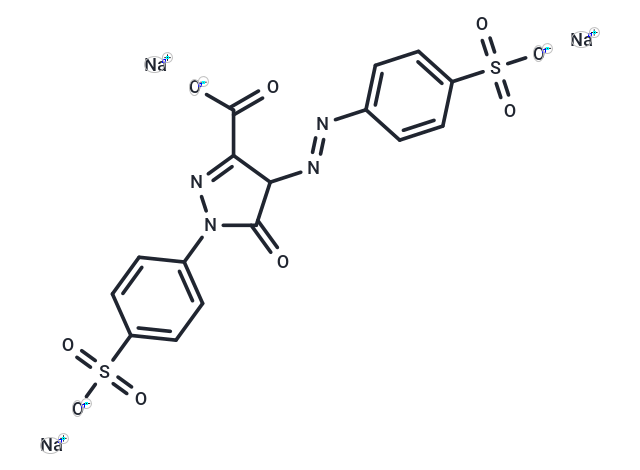Shopping Cart
- Remove All
 Your shopping cart is currently empty
Your shopping cart is currently empty

Tartrazine (Acid Yellow 23) is a food additive that belongs to a class of artificial dyes and contains an azo group; it has significant genotoxic effect , may be harmful to health and its prolonged use could trigger carcinogenesis.

| Pack Size | Price | Availability | Quantity |
|---|---|---|---|
| 500 mg | $42 | In Stock | |
| 1 g | $50 | In Stock | |
| 1 mL x 10 mM (in DMSO) | $46 | In Stock |
| Description | Tartrazine (Acid Yellow 23) is a food additive that belongs to a class of artificial dyes and contains an azo group; it has significant genotoxic effect , may be harmful to health and its prolonged use could trigger carcinogenesis. |
| In vitro | We assessed the cytotoxicity of Tartrazine by 3-(4,5-Dimethyl-2-thiazolyl)-2,5-diphenyl-2H-tetrazolium bromide test and the response of DNA repair through comet assay (alkaline version). We used different concentrations of the dye, ranging from 0.25-64.0 mM. The results demonstrated that Tartrazine has no cytotoxic effects. However, this dye had a significant genotoxic effect at all concentrations tested. Although most of the damage was amenable to repair, some damage remained higher than positive control after 24 h of repair[2] |
| Alias | FD&C Yellow No. 5, Acid Yellow 23 |
| Molecular Weight | 534.36 |
| Formula | C16H9N4Na3O9S2 |
| Cas No. | 1934-21-0 |
| Smiles | O=C([O-])C(C1/N=N/C2=CC=C(C=C2)S(=O)([O-])=O)=NN(C1=O)C3=CC=C(C=C3)S(=O)([O-])=O.[Na+].[Na+].[Na+] |
| Relative Density. | 2.121 g/cm3 at 20℃ |
| Storage | keep away from direct sunlight | Powder: -20°C for 3 years | In solvent: -80°C for 1 year | Shipping with blue ice. | ||||||||||||||||||||||||||||||
| Solubility Information | DMSO: 40 mg/mL (74.86 mM), Sonication is recommended. H2O: 45 mg/mL (84.21 mM), Sonication is recommended. | ||||||||||||||||||||||||||||||
Solution Preparation Table | |||||||||||||||||||||||||||||||
DMSO/H2O
| |||||||||||||||||||||||||||||||

Copyright © 2015-2025 TargetMol Chemicals Inc. All Rights Reserved.